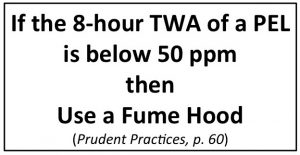 In addition to skin contact, substances can be hazardous simply by being exposed to the atmosphere because the harmful vapors can then come in contact with or be absorbed into a person’s body. Therefore, most substances have some guidelines for exposure, such as OSHA’s Permissible Exposure Limits (PEL) or ACGIH’s Threshold Limit Values (TLV).
In addition to skin contact, substances can be hazardous simply by being exposed to the atmosphere because the harmful vapors can then come in contact with or be absorbed into a person’s body. Therefore, most substances have some guidelines for exposure, such as OSHA’s Permissible Exposure Limits (PEL) or ACGIH’s Threshold Limit Values (TLV).
OSHA set PELs to protect workers against the health effects of exposure to hazardous substances. The PELs are limits on the concentration of a substance in the air, and they may also contain a skin designation. The numbers are usually expressed in parts per million (ppm) or mg/m3.
In 1989, federal OSHA revised its PELs under 29 CFR 1910.1000, which Minnesota OSHA adopted. Although federal OSHA has since reverted to the pre-1989 PELs, Minnesota OSHA still enforces the 1989 PELs for substances that are not covered by separate standards.
- The PELs (found in Table Z-1-A) are measured in one of three ways:
- Ceiling is the employee’s exposure that shall not be exceeded during any part of the work day. If instantaneous monitoring is not feasible, then the ceiling shall be assessed as a 15-minute time weighted average exposure which shall not be exceeded at any time over a working day.
- Time Weighted Average (TWA) is the employee’s average airborne exposure in any 8-hour work shift of a 40-hour work week which shall not be exceeded.
- Short Term Exposure Limit (STEL) is the employee’s 15-minute time weighted average exposure that shall not be exceeded at any time during a work day unless another time limit is specified in a parenthetical notation below the limit. If another time period is specified, the time weighted average exposure over that time period shall not be exceeded at any time during the working day.
- An employee’s exposure to any substance listed in Table Z-1-A shall not exceed the Time Weighted Average (TWA), Short Term Exposure Limit (STEL) and Ceiling Limit specified for that substance in Table Z-1-A.
- An Action Level, calculated as an eight (8)-hour time-weighted average (and generally lower than the PEL), is a concentration designated for specific substances listed in 29 CFR part 1910 that initiates certain required activities such as exposure monitoring and medical surveillance.
- For example, the PEL for lead is 50ug/m3 while the Action Level is 30ug/m3.
- Actions Levels must be followed.
The American Conference of Governmental Industrial Hygienists (ACGIH; http://www.acgih.org) is “an organization devoted to the administrative and technical aspects of occupational and environmental health.” The TLVs® and BEIs® were developed by the ACGIH to “recommend airborne concentrations of agents and exposure conditions for use in the practice of industrial hygiene and by other qualified professionals to protect worker health.”
- TLVs® andBEIs® are not regulatory standards, but they do represent a scientific opinion based on a review of existing peer-reviewed scientific literature by committees of experts in public health and related sciences.
- TLVs® andBEIs® (when known) can be found on Safety Data Sheets and in PubChem.
You must be logged in to post a comment.